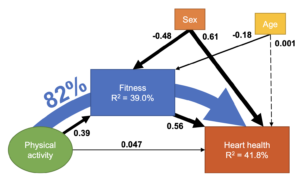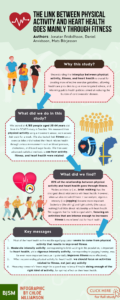Authors: Jonatan Fridolfsson, Daniel Arvidsson, Mats Börjesson
Why is this study important?
It is well established that both being active and having a good fitness (maximal oxygen consumption) are good for heart health. Some studies suggest that fitness is the key factor in explaining the benefits of physical activity on heart health, while others indicate that activity and fitness have independent effects. Understanding the interplay between physical activity, fitness, and heart health is crucial for creating more effective exercise guidelines, allowing healthcare providers to give more targeted advice, and informing public health policies aimed at reducing the burden of cardiovascular disease.
Our study aimed to investigate this complex relationship, with a particular focus on how the intensity of physical activity is related to heart health, both directly and through fitness.
How did the study go about this?
We looked at 4,185 people aged 50-64 years old from the SCAPIS-study in Sweden. We measured their physical activity using a movement sensor, worn around their waist for a week. We also tested their fitness on an exercise bike and checked their heart-related health through various measurements such as blood pressure, cholesterol, and blood sugar levels. We then used advanced statistical methods to see how activity, fitness, and heart health were related. These methods allowed us to look at the whole range of activity intensities, from very light to very vigorous, and how they each related to fitness and heart health.
What did the study find?
We found that 82% of the relationship between physical activity and heart health goes through fitness. When we looked at different intensities of activity, we saw that moderate intensity corresponding to brisk walking had the strongest direct relationship with heart health. However, when we also included fitness in our analysis, vigorous intensity (like jogging) became more important. This indicates that most of the benefits of being active on heart health come from improving one’s fitness.
Interestingly, we found that sedentary (like sitting) and light activity (like casual walking) had little direct relationship with heart health. This doesn’t mean these activities are not important, but it suggests that for middle-aged adults, focusing on activities that are intense enough to increases fitness is more beneficial for heart health.

What are the key take-home points?
- Most of the heart health in the middle-aged population seems to come from physical activity that results in improved fitness.
- Moderate intensity activity, corresponding to brisk walking in this population, is important for heart health, while vigorous intensity activity, corresponding to jogging/running, may be even more important because it potentially improves fitness more effectively.
- When recommending physical activity for heart health, we should focus on activities related to fitness, not just any activity.
- Measuring someone’s fitness might be a good way to know if they’re doing enough of the right kind of activity, for optimal effect on their heart health.
In practice, this means that when advising people about physical activity for heart health, we should encourage them to do activities that make them breathe harder and increase their heart rate. While any activity is good, activities that improve fitness seem to be particularly beneficial for heart health. However, it’s important to note that vigorous intensity activities may carry certain risks, especially for individuals with existing medical conditions. The findings of this study could help shape more effective physical activity guidelines and interventions, focusing on improving fitness as a key pathway to better heart health.
